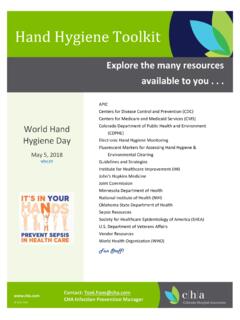Transcription of Health, Hygiene and Sanitation - ASTEC
1 Sub-Theme-II. health , Hygiene and Sanitation health , Hygiene and Sanitation Background health is the level of functional and metabolic efficiency of a living organism. The World health Organization (WHO-2006) defined human health in its broader sense as a state of complete physical, mental, and social well-being and not merely the absence of disease or infirmity . (http:/. ). health , or health and well-being, are also includes a supportive environment, personal security, freedom of choice, social relationships, adequate employment and income, access to educational resources, and cultural identity (Diaz et al., 2006;. Millennium Assessment 2005). Over the last decade, health promotion practitioners have increasingly been asked to think about the relationships between humans and the environment in terms of ecosystems (Brown, 1994) and to adopt an ecological' approach to health promotion (Kickbusch, 1989) with the environment an integral part of human development (Hancock, 1993a).
2 Hygiene is a set of practices performed to preserve health . According to the World health Organization (WHO), Hygiene refers to conditions and practices that help to maintain health and prevent the spread of diseases. Hygiene is a concept related to cleanliness, health and medicine. It is as well related to personal and professional care practices. In medicine and everyday life settings, Hygiene practices are employed as preventative measures to reduce the incidence and spreading of disease. Hygiene practices vary, and what is considered acceptable in one culture might not be acceptable in another. In the manufacturing of food, pharmaceutical, cosmetic and other products, good Hygiene is a critical component of quality assurance. The terms cleanliness and Hygiene are often used interchangeably, which can cause confusion. In general, Hygiene refers to practices that prevent spread of 45. disease-causing organisms. Cleaning processes ( , hand washing ) remove infectious microbes as well as dirt and soil, and are thus often the means to achieve Hygiene .
3 Sanitation generally refers to the provision of facilities and services for the safe disposal of human urine and feces. The word Sanitation ' also refers to the maintenance of hygienic conditions, through services such as garbage collection and wastewater disposal.(WHO). Environmental Sanitation envisages promotion of health of the community by providing clean environment and breaking the cycle of disease. It depends on various factors that include Hygiene , status of the people, types of resources available, innovative and appropriate technologies according to the requirement of the community, socioeconomic development of the country, cultural factors related to environmental Sanitation , political commitment, capacity building of the concerned sectors, social factors including behavioral pattern of the community, legislative measures adopted, and others. India is still lagging far behind many countries in the field of environmental Sanitation .(Pandve, 2008). Ecological Sanitation , which is commonly abbreviated to ecosan, is an approach, rather than a technology or a device which is characterized by a desire to close the loop (mainly for the nutrients and organic matter) between Sanitation and agriculture in a safe manner.
4 Put in other words: Ecosan systems safely recycle excreta resources (plant nutrients and organic matter) to crop production in such a way that the use of non-renewable resources is minimized . When properly designed and operated, ecosan systems provide a hygienically safe, economical, and closed-loop system to convert human excreta into nutrients to be returned to the soil, and water to be returned to the land. Ecosan is also called resource- oriented Sanitation Sustainable Sanitation considers the entire Sanitation value chain , from the experience of the user, excreta and wastewater collection methods, transportation or conveyance of waste, treatment, and reuse or disposal. The term is widely used since about 2009. In 2007. the Sustainable Sanitation Alliance defined five sustainability criteria to compare the sustainability of Sanitation systems. In order to be sustainable, a Sanitation system has to be economically viable, socially acceptable, technically and institutionally appropriate, and it should also protect the environment and the natural resource Sustainable Development the core concept for the Post-2015 Development Agenda.
5 Provides an integrated response to the complex environmental, societal, economic and governance challenges that directly and disproportionately affect children. With appropriate focus, investment and innovation, the Post-2015 Development Agenda presents an unprecedented opportunity to create a World Fit for All Children. 46. The relationship between children and sustainable development is symbiotic. Progress in sustainable development underpins child rights and well-being, and conversely, child rights and well-being underpin lasting and equitable development progress. Finding the balance to achieve progress for all in today's world and for future generations depends upon three key propositions: 1. Sustainable development starts with safe, healthy and well-educated children;. 2. Safe and sustainable societies are, in turn, essential for sensitive groups such as children, women and elderly; and 3. Children's voices, choices and participation are critical for the sustainable future we want.
6 Focus of the Sub theme The primary objective of this sub theme is to explore, document and analyze the role of health , Hygiene and Sanitation on the health of not only humans but of the entire ecosystem and thus its impact on sustainable development in terms of use of science, technology and innovative approaches and ideas. The brief objectives are could be : i. Identifying the status of prevailing sanitary and Hygiene conditions which affect the health and wellbeing of living beings. This may in turn have major impact on economic productivity, since inadequate Sanitation impacts individuals, households, eco systems, communities and nations as a whole. ii. Addressing mental health problems amongst children and adolescents which include depression, anxiety, eating and sleeping disorders that can be attributed to several reasons such as decrease in physical activities, spending too much time in the virtual world which put such children at risk of delayed emotional and social development.
7 Iii. Improving health conditions of the urban/peri-urban and rural citizens, especially children, women and elderly through providing access to safe drinking water, Sanitation and introducing preventive interventions in domestic places, workplaces and outdoors. Logical Frame work Natural & Man-made Systems Hygiene & Sanitation Preventive & Safety (Domestic/Workplace/Outdoors) Interventions Curative Interventions Well-being Social (Physical & Mental State) Environmental Economical Flow chart showing relationship of health , Hygiene and Sanitation with sustainable development 47. Scope The strong synergies between health and nutrition (World Bank 2013) are well-documented;. good health is not possible without good nutrition. Malnutrition remains one of the main determinants of the global burden of disease, with 45% of child mortality attributable to under nutrition (Black et. al. 2013). The major challenges faced by the Sanitation sector are the lack of proper Sanitation for the majority, ill effects owing to poor Sanitation , water shortage and pollution, food insecurity and unplanned urban growth.
8 The population un-served by Sanitation facility is about 40% of the world population. Approximately 6000 children die every day from diarrheal diseases related to inadequate Sanitation and Hygiene . About 1 billion people worldwide-mostly children - are infested with intestinal worms and as a result suffer from nutritional deficiency and poor growth. Both these groups of diseases are mostly transmitted through unhygienic conditions. Sewage discharges are a major component of water pollution all over the world. Only a small portion of the polluted water is treated before it is discharged into open water channels or bodies. Pollutants Components of SDG 6: Availibility also leak into ground water from sewers, septic tanks, and Sustainable Management of Water and Satition for All soak pit toilets and cesspools. By 2030, more than half of world population will face shortage of water. DRINKING. WATER. The Sanitation practices promoted today are either based ECO- Sanitation .
9 On hiding the human excreta in deep pits (drop-and- SYSTEM SDG 6 AND. CLEAN HYGINE. store) or on flushing them away and diluting them in WATER AND. Sanitation . rivers, lakes and the sea (flush-and discharge). Whereas ecological Sanitation is based on three fundamental WATER WATER. principles which are preventing pollution rather than MANAGE- QUALITY. MENT. attempting to control it after we pollute; sanitizing the urine WATER-USE. and faeces; and using the safe products for agricultural EFFIENCY. purposes (sanitize and recycle). 48. Spurred on by Agenda Goals, along with changing national realities, many low and middle- income countries will need to invest heavily in Sanitation in the next decade. The decisions they make and the approaches they take today will have far-reaching consequences for sustainability and for the well-being of their citizens. Sanitation is an integral piece of the sustainable development puzzle. The right Sanitation systems can not only minimize health and environmental risks associated with open defecation and poorly managed waste disposal, but also, in many cases, yield multiple benefits in areas from health to food security, resilient livelihoods, business growth, energy, and ecosystem services.
10 The Initiative focus on productive Sanitation approaches. Hygiene - specifically hand- washing with soap - is one of the most important interventions for human health and development and is a universal necessity. Fundamental to fighting under nutrition, reducing child mortality, overcoming antibiotic resistance, and advancing access to education , Hygiene underpins the delivery of several other SDGs and ultimately advances gender equity, dignity, and human rights. Promotion and demonstration of safe Hygiene practices , hand- washing with soap, food Hygiene , menstrual Hygiene management, safe stool disposal, and solid waste management at the household, community and institutional level needs to be carried out collaboratively with the health , education , community development and business development sectors . The success of these programs involves ensuring that schools and health facilities enable the practice of safe Hygiene behaviors and those health workers and educators are trained on appropriate behavior change Communication.









